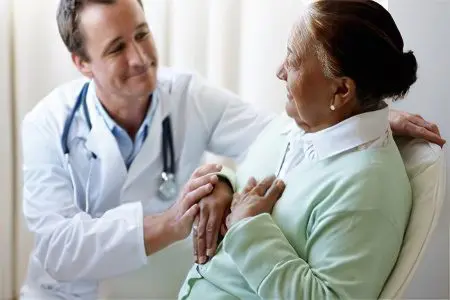Contents
What is rheumatism?
Rheumatism is a systemic inflammatory disease that is localized mainly in the lining of the heart. At risk are people who have a hereditary predisposition to this disease and age from 7 to 15 years. Rheumatism usually affects adolescents and young people, less often – elderly and debilitated patients.
Rheumatic heart disease is one of the leading causes of death (approximately 50 people die of this disease every year in the United States). Often this disease begins in the cold season, especially in northern latitudes. Rheumatism is not an epidemic disease, although the streptococcal infection that precedes it may take on the character of an epidemic. For this reason, rheumatism can start immediately in a group of people – for example, in schools, orphanages, hospitals, military camps, poor families and cramped living conditions.
Bacteriological and serological studies have shown that rheumatism is a specific allergic reaction to infection with one of the group A beta-hemolytic streptococci.
Within a month, 2,5% of those who had a streptococcal infection begin to suffer from acute rheumatism. Often diseases such as tonsillitis, scarlet fever, puerperal fever, acute inflammation of the middle ear and erysipelas precede the development of rheumatism. The body does not develop immunity to infection, and in response to a second infection, an autoimmune attack begins.
Etiology of rheumatism

Rheumatism is a complex pathological process of impaired connective tissue synthesis, affecting mainly the musculoskeletal system and the heart.
Despite the fact that in modern research and practice, rheumatism is defined in several ways, the essence of the pathological process is the same.
The development of rheumatic pathology is based on disruption of the connective tissue cells and destruction of the intercellular substance. The main change is the destruction of the collagen fibers that form the tissues of the joints and heart. For this reason, the heart suffers most (primarily valves), blood vessels and the musculoskeletal system (joints and cartilage).
The etiology of rheumatism today is represented by three theories:
Complex theory. It proceeds from the multiplicity of causes of the formation of rheumatism, including an allergic reaction and bacterial damage (by organisms of the genus streptococci);
Infectious theory. It comes from the fact that the main cause of the development of rheumatism is the streptococcus bacterium;
Bacterial-immunological theory. Its essence lies in the fact that the microorganism is a trigger of the disease, leading to an immune response and, as a result, the destruction of connective tissue substances.
Complex theory
According to the complex theory, rheumatism is a polyetiological process that includes several aspects. Unlike the bacterial-immunological theory, here we are talking about a microorganism as an independent cause, and not a trigger.
This concept is based on the idea of the formation of the disease as a result of the penetration of streptococcal infection into the tissues of the body and the dislocation of bacteria in the heart and joints (they are carried with the bloodstream).
However, a necessary condition is repeated contact with the pathogen, which leads to an increase in the sensitivity of the body. As a result, the body becomes less resistant to the effects of a particular strain of streptococcus, and the immune response is not able to completely suppress the development of infection.
The concentration of antibodies, however, is high enough to have a destructive effect on the cellular structures and intercellular substance of the organism itself. The substances produced by streptococcus have the same effect.
Both bacteria and antibodies equally adversely affect the body, provoking rheumatism. In confirmation of the theory, streptococcus is often found in the study of samples (tests) handed over by patients with rheumatism.
Infection theory
It comes from the only cause of the disease – a bacterial infection. In the fluid taken from patients with rheumatism from the pleural cavity or pericardium, specific pathogenic particles are found, which confirms the theory.
Bacterial-immunological theory
Gives immunity a dominant role in the mechanism of the development of the disease. The reason is that a high concentration of antibodies to streptococcus is found in the blood of patients, but tests for streptococcus itself also remain positive. Therefore, the body’s immune response acts in this case as a destructive factor.
Within the framework of this theory, the microorganism does not have a significant effect on a person and is only a trigger.
Thus, all theories point to the complex nature of the disease, which is based on infection and immune response.
Causes of rheumatism

There are three main causes of rheumatism:
Past streptococcal infections (tonsillitis, etc.);
Immune (allergic) reaction;
Genetic predisposition.
Past illnesses
As it was said, only streptococci (group A streptococcus, beta-hemolytic) affect the formation of the disease, and only with repeated interaction, as a result of which the protective ability of the body decreases.
Since there are serological subgroups within the group of microorganisms, it is important to say that the interaction should be carried out with streptococcus of the same subgroup. This explains why rheumatism does not develop after any cold.
The risk of developing rheumatism is also higher with a single contact if the patient does not receive the necessary treatment. The disease becomes chronic, and the patient develops a bacterial focus that can at any time provoke rheumatism and other serious complications.
Allergic reaction
A severe allergic reaction can be caused by both the streptococcus itself and the substances it secretes (toxins and enzyme proteins). Since the pathogen spreads throughout the body with the bloodstream, the immune response can be systemic, but most of all it manifests itself in lesions of the heart and joints.
According to research, bacteria are responsible for the development of acute rheumatism involving the joints (this is the classic form of the disease).
However, chronic rheumatism is not associated with a streptococcal lesion, since, according to the results of the tests, neither antibodies to streptococcus nor streptococcus itself are detected. There is also no effectiveness of preventive measures against relapses of rheumatism. These arguments speak in favor of an unexplored allergic or autoimmune process.
Genetics
The disease is not transmitted genetically, however, the predisposition to the disease passes by “inheritance”. This is due, first of all, to the similarity of the immune systems of the parents and the child, and since rheumatism is predominantly an immune disease, the mechanism of its development and causes are similar to other allergic pathologies (Hashimoto’s thyroiditis, bronchial asthma, etc.).
Symptoms of rheumatism

Rheumatism is not a single disease. Often it “sides” with other pathologies for the reason that the harmful substances secreted by streptococcus and immune antibodies damage many organs and systems, and all these manifestations can be considered as forms of rheumatism.
The first symptoms of rheumatism do not allow to diagnose the disease. They appear 2-3 weeks after a repeated infection of the upper respiratory tract (pharyngitis, laryngitis, tonsillitis) with an established streptococcal lesion. The picture looks like a relapse of a cold. Symptoms of acute rheumatism are an increase in body temperature, sometimes up to 40 ° C, increased heart rate, chills, excessive sweating, loss of strength, swollen and painful joints. First of all, the largest and most actively used joints suffer.
Further, the inflammation spreads to the remaining joints, often symmetrically. The joints are very swollen, reddened, hot to the touch, with pressure and movement pain is felt. Usually, the inflammatory process does not lead to stable changes in the joints. The pulse is frequent, arrhythmic, there is pain in the chest, dilatation (expansion) of the heart, sometimes a pericardial friction rub is heard – this indicates heart damage.
General symptoms of rheumatism:
Hyperthermia. Body temperature rises to dangerous levels (38.0-40.0 ° C). The symptom is associated with the development of an acute immune reaction against pathogens;
Lethargy. As patients describe, the body becomes “cotton”, you constantly want to sleep;
Headache. Localized in the forehead.
Specific symptoms of rheumatism:
Joint pain. First of all, large joints (knee, elbow), pains of a pulling nature, dull and long-lasting are affected. Rheumatism is characterized by the rapid development of the process, and the same rapid disappearance of inflammation and pain in the joints with the restoration of their functions;
Pain behind the sternum. Pain in the region of the heart of a dull or aching character. The symptom does not appear immediately, but after a day or several days;
Vascular disorders Fragility of blood vessels, nosebleeds and more;
Annular eruptions. They appear in no more than 4-10% of all cases. They look like a pink rash, forming roundness with jagged edges. Does not disturb the patient in any way;
Rheumatic knots. Formed on the affected joints. They look like subcutaneous formations from 5 mm to 2-3 cm in diameter, dense and motionless, but painless. They appear extremely rarely and persist for about 2 months from the onset of the course of the disease.
Specific symptoms appear only after 1-3 days. Occasionally, there are symptoms of damage to the abdominal organs (pain in the right hypochondrium, etc.), which indicates a severe course of the disease and requires immediate hospitalization).
Rheumatism in children occurs in a milder form or chronic, without any special symptoms. General malaise, rapid pulse and pain in the joints are noted, pain is not felt during movement (the so-called “growing pains”). If there are no signs of heart damage, then the disease rarely ends in death, although with the development of carditis, the average life expectancy of patients in the future is significantly reduced.
Signs of rheumatism

Other signs of rheumatism include:
Secondary. The disease is formed as a result of the development of a chronic focus of unique beta-hemolytic streptococci. Therefore, the manifestations of the disease do not occur immediately, but after a certain period (several weeks);
Polyetiology. The disease is caused by both antibodies of lymphocytes and toxins, as well as enzymatic substances of streptococcus;
Tendency to relapse. After the first course of rheumatism in the acute form, the disease, even with successful treatment, becomes chronic with frequent relapses;
Monopathology. For rheumatism, regardless of its etiology, a specific single complex of symptoms is characteristic, indicating damage to the heart, blood vessels, cartilage and joints. The heart suffers most of all, the tissues of which are destroyed under the influence of antibodies. The mechanism of defeat is also the same;
Many comorbidities. Some doctors refer to comorbidities as forms of rheumatism. This is not entirely accurate, besides, they do not appear in all patients and not always. Among them are chorea (nervous disease), erythema nodosum and others;
Self-treatment of symptoms. The symptoms of acute rheumatism pass on their own and as rapidly as they arose (the exception is cases of severe course, when acute heart failure is observed);
Unpredictability. Symptoms subside after some time, but it is impossible to accurately predict it. Even during the course of treatment, relapses occur. The recurrence rate also varies. The disease can “calm down” for a long time, and then reappear, or it can make itself felt every month. The duration of relapse cannot be accurately predicted;
Swiftness. The first specific symptoms develop rapidly and all at once;
Difficulty in diagnosis. Rheumatism has manifestations similar to other diseases. Since vivid symptoms indicating pathology can be found very often, rheumatism is easy to “miss”. For example, with damage to the joints, with rheumatoid arthritis, but this is a completely different disease that has nothing to do with rheumatism.
Diagnosis of rheumatism

With absolute accuracy, none of the diagnostic manipulations will indicate the presence of rheumatism. Only by evaluating the data obtained in a complex, an experienced specialist can conclude that the disease exists. This makes the diagnosis of this disease difficult.
Diagnostic measures include a number of laboratory and instrumental studies:
Ultrasound diagnosis;
Cardiography (ECG);
Blood tests.
US
An ultrasound of the heart (also known as an echocardiogram) evaluates the condition of the valves, as well as the ability to contract. As rheumatism develops, changes in the activity of the heart increase. Thanks to echocardiography, it is possible to identify defects in the early stages and take the necessary actions in time.
Cardiography (ECG)
The study allows you to clarify the degree of nutrition of the heart muscle. ECG detects the slightest violations of cardiac activity and displays them graphically using a special sensor. It is most effective to conduct a series of cardiographic studies within a few days, because rheumatism is a constant violation, and changes in the work of the heart are best seen in dynamics.
Assays
For the diagnosis of rheumatism, venous blood is taken. The following indicators should alert the doctor:
Leukocytosis – an increased content of leukocytes;
Protein disorders of the blood;
The presence of antibodies to streptococci;
Detection of antibodies to streptococcal enzyme substances (ASL-O);
Identification of a specific C-reactive protein;
Decrease in hemoglobin;
Increase in ESR.
Also, the doctor during the initial examination can detect symptoms of polyarthritis (swelling of the joints, redness, joints hot to the touch). Together, these diagnostic manipulations make it possible to establish the diagnosis of rheumatism with high accuracy.
To make a diagnosis, it is important that one of the following sets of symptoms occurs:
Violation of the heart (carditis) and the release of antibodies against streptococcus from the patient’s blood;
Violation of the heart and the presence of two laboratory parameters indicating rheumatism;
Violation of the heart and pronounced external manifestations (swelling of the joints, etc.);
Two specific signs in history (inflammation of the joints, disorders of the heart, chorea, skin rashes, rheumatic nodes) and one non-specific (cardiac arrhythmias, hyperthermia, changes in laboratory tests of the type indicated above, etc.);
One specific sign and three non-specific.
Forms of rheumatism and its classification

The main classification adopted by rheumatologists includes two types of rheumatism.
Acute rheumatism
Rheumatism in the acute phase is most often manifested in young people under 20 years of age. The causative agent is streptococcus. The association of the disease with previous infections of the upper respiratory tract lies in the delayed manifestation of symptoms (14-21 days).
Acute rheumatism develops rapidly. First, symptoms of general intoxication appear, as with a cold, which does not allow you to immediately determine the disease, then after a day or two, specific symptoms appear (polyarthritis, carditis, skin rashes, and very rarely, nodules). The acute phase lasts, on average, up to 3 months. Perhaps a longer course (up to six months). The most dangerous in acute rheumatism is heart damage (carditis), because. in 1/4 of all cases, it contributes to the formation of heart disease.
Chronic rheumatism
The chronic form is characterized by a frequent relapsing course, even during therapy. Exacerbations occur at any time of the year. Especially often in cold seasons (autumn, winter). Patients living in damp or cold apartments are subject to the same effect. Exacerbations – several times a year. Most patients (about 85%) are under 40 years of age.
The joints and heart are affected. The course of the disease is severe and significantly reduces the quality of life. The patient experiences constant pain in the joints and heart. After the acute phase (relapse) passes, the sluggish course can last for several months, or even years.
Rheumatism classification
Rheumatism is divided into forms according to the criterion of the affected system or organ:
Cardiac form of rheumatism. Otherwise, rheumatic heart disease. In this case, the muscular structures of the heart are affected. It may disturb the patient with severe pain, and may barely manifest itself. But destructive processes will still go on. In the first stages, the course is almost imperceptible and is detected only with the help of an ECG. In the later stages of formation, it causes severe damage to the heart and acute heart failure against the background of a decrease in the nutrition of the muscles of the organ and, as a result, a decline in contractility. It is manifested by violations of the heart rhythm (tachycardia) and is detected by ultrasound (ECHOCG);
Articular form of rheumatism. It can exist as an independent clinical manifestation of rheumatism, or in conjunction with heart disease. With this form of the disease, large joints are affected. At a later stage, small joints are also involved in the process. With rheumatism, under the influence of antibodies of lymphocytes and streptococcus enzymes, the articular bag and the cartilage itself are destroyed. Therefore, the diagnosis is not a problem: the joint looks very swollen and red. The patient cannot move the affected limbs because severe pain occurs. The acute phase of the articular form is characterized by an increase in body temperature up to 38-39 ° C;
Damage to the nervous system. The neurological form is somewhat less common. With this form of the disease, the cells-neurons of the cerebral cortex responsible for motor activity are damaged. Their involuntary stimulation by active substances leads to the fact that the patient has spontaneous uncontrolled muscle movements. This is manifested by twitching of the limbs and grimaces. The form is extremely unpleasant, because it complicates the social life of a person and interferes with self-service in everyday life. Symptoms last 2 to 4 weeks. In a dream, there are no manifestations;
Lung form. It manifests itself in combination with damage to the joints and heart, but is extremely rare (about 1-3% of the total number of clinical cases). Develops in the form of pleurisy or bronchitis;
Every form. It manifests itself as skin rashes, or rheumatic nodules. Occurs in no more than 5% of cases;
Ophthalmic form. It is diagnosed only in combination with the “classic” symptoms of rheumatism. It consists in damage to the retina (retinitis), or other structures of the eye (iritis, iridocyclitis, etc.). It can cause complete or partial loss of vision.
Complications of rheumatism
Complications of past rheumatic fever include:
Chronic relapsing course. The disease can become chronic;
Development of heart defects. The formation of defects occurs in 25% of cases of the transferred acute phase of pathology. The defect affects the main muscle structures of the heart and leads to a decrease in the quality of the organ;
Chronic heart failure. The heart, being affected by rheumatism, ceases to cope with its functions. There may be diffuse changes, decreased cardiac contractility and rhythm disturbances;
thromboembolic and ischemic disorders. As a result, foci of ruptures or blockages (strokes) of blood vessels may occur, including the retina, renal arteries, etc.;
Inflammation of the membranes of the heart. It is infectious in nature and can pose an immediate danger to the life of the patient.
How to treat rheumatism?
Bicillin
Rheumatism is a pathology that has a mixed immune-bacteriological nature. Therefore, it is difficult to treat and almost never completely cured. Since the primary source of the disease is a streptococcal bacterium (and the immune reaction is secondary and is a response to the “attack” of a foreign organism), the main task of treatment is to eliminate bacteria and quickly remove their waste and decay products.
The main (and main) drug for combating the causative agent of the disease is bicillin (it is an antibiotic of the penicillin series, it has a longer effect than ordinary penicillin).
The first (active) phase of antibiotic therapy lasts from 10 to 14 days. Studies show that a shorter period is inappropriate, since the infection persists, and a longer one is ineffective, since streptococcus begins to produce substances that destroy the antibiotic, and the antibiotic becomes harmful to the patient himself.
Then the second (passive) phase begins. Three weeks after the end of oral administration of bicillin, the same drug is administered intramuscularly to the patient. Such treatment should be continued for 5-6 years (1 injection every 3 weeks) to reduce the chance of recurrence and prevent possible heart complications.
Hormonal preparations
In the treatment of severe forms of rheumatism, prednisolone is used in the maximum allowable dosage, as prescribed by the doctor.
General recommendations
If the disease is mild, half-bed rest is prescribed for up to 10 days. If there is a severe course, it is necessary to exclude any physical activity, because it aggravates the process. Bed rest is prescribed for up to a month.
To evaluate the effectiveness of treatment, laboratory tests are used. As soon as the indicators approach normal values, bed rest can be canceled. If the disease is severe, with severe heart rhythm disturbances, joint pain, inpatient treatment is necessary, which lasts up to two months.
Disability due to rheumatism

There is no single list of diseases in which the patient is guaranteed to be diagnosed with a degree of disability.
Medical commissions determine the disability group based on three main criteria:
Ability to self-service;
General health and quality of life;
Employability and employment opportunities.
Depending on the severity of the course of rheumatism, the ability to self-care, as well as to independent movement, may drop sharply. Many labor factors can cause an exacerbation in patients, for example, work associated with physical exertion or high physical activity. The quality of life is determined by the frequency of relapses and the severity of their course.
Based on these criteria, medical commissions assign patients either the third or the second group of disability. There are rare cases of the appointment of the first group.
III Group is prescribed if there are no pronounced functional disorders, the patient is able to serve himself, and manifestations of relapses occur no more than 3 times a year. Disability limitations in this case are minimal and relate only to physical activity and immobilization during periods of exacerbations.
II Group can be prescribed if the patient has vivid manifestations of rheumatism. Exacerbations are frequent (more than 3 times a year), the ability to self-service is reduced during periods of exacerbations. Employment is permissible in places where constant physical activity is not required, there is no dampness and cold.
I Group prescribed in case of severe functional disorders. Exacerbations are frequent and protracted. Even during periods of remission, the symptoms persist and manifest in the form of pain in the joints and heart. Ability to work is significantly impaired, periods of inability to work range from 3 months to six months.
Prevention of rheumatism
Prevention of initial streptococcal infection is the only possible measure for the prevention of rheumatic fever. If you start antibiotic treatment in a timely manner, then the likelihood of developing the disease is minimized.
Preventive measures can reduce the likelihood of the disease:
Enhance immunity. The main cause of rheumatism is the penetration of streptococcal infection with blood flow to organs and systems. Most often, the cause of the unimpeded penetration of the infection is a reduced immunity, unable to suppress the activity of the pathogen in time. To strengthen the immune system requires the right fortified diet and proper rest;
Avoid contact with streptococcus. You should follow the rules of personal hygiene and, if possible, try to get sick with infectious diseases less often. Contact with people infected with streptococcal infection should also be excluded;
Timely treatment of colds. The formation of rheumatism is facilitated not only by repeated contact with the pathogenic bacterium, but also by a long period without treatment. At the first symptoms of a cold, you should immediately consult a doctor. Moreover, this recommendation applies to persons with a confirmed streptococcal lesion or who have already had the disease before;
Preventive sanitation after contact with the pathogen. It is recommended to take bicillin in an adequate dosage (1,5 million units once, intramuscularly).
Thus, rheumatism is complex, both in terms of etiology and in terms of symptoms. The disease is not well understood, therefore, there are difficulties in making a correct diagnosis, and it is also not completely cured.
However, modern methods of treatment make it possible to eliminate the negative manifestations of pathology, minimize the danger to life and harmful consequences, and also ensure a high quality of life for patients with rheumatism.









